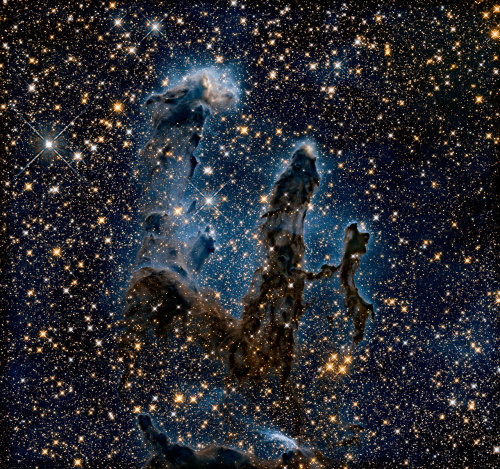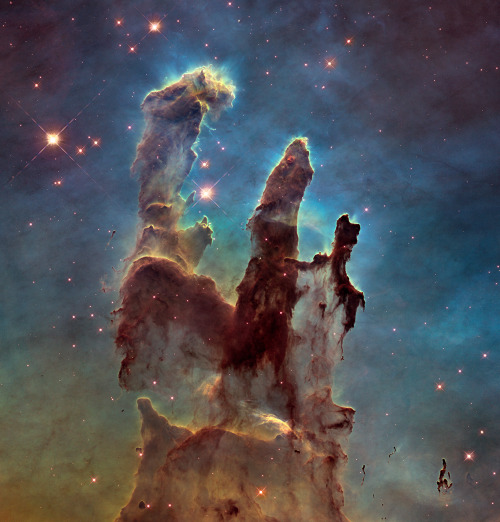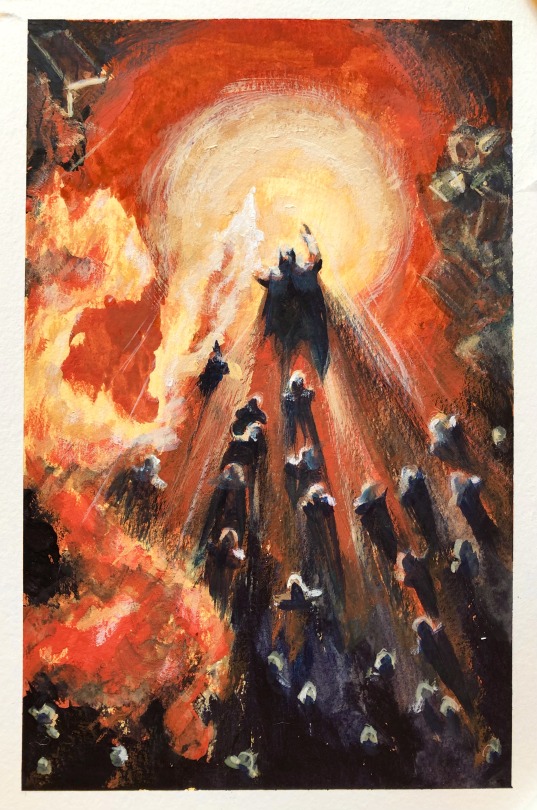Sometimes… There’s More Than Meets The Eye. 👀 You’re Looking At Two Very Different Takes On


Sometimes… there’s more than meets the eye. 👀 You’re looking at two very different takes on an iconic image.
Human eyes can see only a small portion of the range of radiation given off by the objects around us. We call this wide array of radiation the electromagnetic spectrum, and the part we can see visible light.
In the first image, researchers revisited one of Hubble Space Telescope’s most popular sights: the Eagle Nebula’s Pillars of Creation. Here, the pillars are seen in infrared light, which pierces through obscuring dust and gas and unveil a more unfamiliar — but just as amazing — view of the pillars. The entire frame is peppered with bright stars and baby stars are revealed being formed within the pillars themselves. The image on the bottom is the pillars in visible light.
Image Credit: NASA, ESA/Hubble and the Hubble Heritage Team
Make sure to follow us on Tumblr for your regular dose of space: http://nasa.tumblr.com.
More Posts from Crispygardenerpizza and Others
I just love space so much man
Cosmic Alphabet Soup: Classifying Stars

If you’ve spent much time stargazing, you may have noticed that while most stars look white, some are reddish or bluish. Their colors are more than just pretty – they tell us how hot the stars are. Studying their light in greater detail can tell us even more about what they’re like, including whether they have planets. Two women, Williamina Fleming and Annie Jump Cannon, created the system for classifying stars that we use today, and we’re building on their work to map out the universe.

By splitting starlight into spectra – detailed color patterns that often feature lots of dark lines – using a prism, astronomers can figure out a star’s temperature, how long it will burn, how massive it is, and even how big its habitable zone is. Our Sun’s spectrum looks like this:

Astronomers use spectra to categorize stars. Starting at the hottest and most massive, the star classes are O, B, A, F, G (like our Sun), K, M. Sounds like cosmic alphabet soup! But the letters aren’t just random – they largely stem from the work of two famous female astronomers.

Williamina Fleming, who worked as one of the famous “human computers” at the Harvard College Observatory starting in 1879, came up with a way to classify stars into 17 different types (categorized alphabetically A-Q) based on how strong the dark lines in their spectra were. She eventually classified more than 10,000 stars and discovered hundreds of cosmic objects!

That was back before they knew what caused the dark lines in spectra. Soon astronomers discovered that they’re linked to a star’s temperature. Using this newfound knowledge, Annie Jump Cannon – one of Fleming’s protégés – rearranged and simplified stellar classification to include just seven categories (O, B, A, F, G, K, M), ordered from highest to lowest temperature. She also classified more than 350,000 stars!

Type O stars are both the hottest and most massive in the new classification system. These giants can be a thousand times bigger than the Sun! Their lifespans are also around 1,000 times shorter than our Sun’s. They burn through their fuel so fast that they only live for around 10 million years. That’s part of the reason they only make up a tiny fraction of all the stars in the galaxy – they don’t stick around for very long.

As we move down the list from O to M, stars become progressively smaller, cooler, redder, and more common. Their habitable zones also shrink because the stars aren’t putting out as much energy. The plus side is that the tiniest stars can live for a really long time – around 100 billion years – because they burn through their fuel so slowly.

Astronomers can also learn about exoplanets – worlds that orbit other stars – by studying starlight. When a planet crosses in front of its host star, different kinds of molecules in the planet’s atmosphere absorb certain wavelengths of light.
By spreading the star’s light into a spectrum, astronomers can see which wavelengths have been absorbed to determine the exoplanet atmosphere’s chemical makeup. Our James Webb Space Telescope will use this method to try to find and study atmospheres around Earth-sized exoplanets – something that has never been done before.

Our upcoming Nancy Grace Roman Space Telescope will study the spectra from entire galaxies to build a 3D map of the cosmos. As light travels through our expanding universe, it stretches and its spectral lines shift toward longer, redder wavelengths. The longer light travels before reaching us, the redder it becomes. Roman will be able to see so far back that we could glimpse some of the first stars and galaxies that ever formed.
Learn more about how Roman will study the cosmos in our other posts:
Roman’s Family Portrait of Millions of Galaxies
New Rose-Colored Glasses for Roman
How Gravity Warps Light
Make sure to follow us on Tumblr for your regular dose of space!
The position that Palestinians are in simply rips my heart out



You telling me explosions trigger PTSD in these IDF imperial soldiers and their supporters ?
maybe if I commit some crimes I'll finally be wanted
Then they'll see.
every single reply to a post on tumblr:
this is the most [insert adjective] thing I have ever read
the good old days..




my brother wanted me to paint That Scene from the batman.
I thought you were talking about the emoji......................
🌿
does it bring you joy?
does it not intentionally hurt/harm anybody else? does it bring you peace? does it seem right, in the now?
if yes, then go for it. whatever it is. it's what you need right now. do it for yourself ✨
therapist: how are you?
me: fine how are you
-
 whateverthewiz reblogged this · 1 month ago
whateverthewiz reblogged this · 1 month ago -
 whateverthewiz liked this · 1 month ago
whateverthewiz liked this · 1 month ago -
 jfictitional liked this · 1 month ago
jfictitional liked this · 1 month ago -
 nvrknowsbest liked this · 1 month ago
nvrknowsbest liked this · 1 month ago -
 carpe-kairos liked this · 1 month ago
carpe-kairos liked this · 1 month ago -
 gomodernart liked this · 1 month ago
gomodernart liked this · 1 month ago -
 powlor liked this · 1 month ago
powlor liked this · 1 month ago -
 abstractandedgyname liked this · 1 month ago
abstractandedgyname liked this · 1 month ago -
 o-blivia reblogged this · 1 month ago
o-blivia reblogged this · 1 month ago -
 thefourthman07 liked this · 1 month ago
thefourthman07 liked this · 1 month ago -
 cybermax reblogged this · 1 month ago
cybermax reblogged this · 1 month ago -
 isbbc liked this · 1 month ago
isbbc liked this · 1 month ago -
 cybermax liked this · 1 month ago
cybermax liked this · 1 month ago -
 kachowwshrek liked this · 1 month ago
kachowwshrek liked this · 1 month ago -
 icyhot65 liked this · 1 month ago
icyhot65 liked this · 1 month ago -
 wafflefriesandbowties reblogged this · 1 month ago
wafflefriesandbowties reblogged this · 1 month ago -
 wafflefriesandbowties liked this · 1 month ago
wafflefriesandbowties liked this · 1 month ago -
 adventurespnw reblogged this · 1 month ago
adventurespnw reblogged this · 1 month ago -
 adventurespnw liked this · 1 month ago
adventurespnw liked this · 1 month ago -
 mysinfulthoughts reblogged this · 1 month ago
mysinfulthoughts reblogged this · 1 month ago -
 whatareyoureallyafraidof reblogged this · 1 month ago
whatareyoureallyafraidof reblogged this · 1 month ago -
 tooshytoexist reblogged this · 2 months ago
tooshytoexist reblogged this · 2 months ago -
 thewriteitinerary reblogged this · 7 months ago
thewriteitinerary reblogged this · 7 months ago -
 jadedpeakearthghoul liked this · 1 year ago
jadedpeakearthghoul liked this · 1 year ago -
 neist reblogged this · 1 year ago
neist reblogged this · 1 year ago -
 brightmane57 reblogged this · 1 year ago
brightmane57 reblogged this · 1 year ago -
 brightmane57 liked this · 1 year ago
brightmane57 liked this · 1 year ago -
 foxysoxes liked this · 1 year ago
foxysoxes liked this · 1 year ago -
 impossiblewizardtraveler-blog reblogged this · 1 year ago
impossiblewizardtraveler-blog reblogged this · 1 year ago -
 impossiblewizardtraveler-blog liked this · 1 year ago
impossiblewizardtraveler-blog liked this · 1 year ago -
 bowlingbum liked this · 1 year ago
bowlingbum liked this · 1 year ago -
 swords0827 liked this · 1 year ago
swords0827 liked this · 1 year ago -
 stefan13exe liked this · 1 year ago
stefan13exe liked this · 1 year ago -
 clonejack liked this · 1 year ago
clonejack liked this · 1 year ago -
 1412kk reblogged this · 1 year ago
1412kk reblogged this · 1 year ago -
 1412kk liked this · 1 year ago
1412kk liked this · 1 year ago -
 whatareyoureallyafraidof reblogged this · 1 year ago
whatareyoureallyafraidof reblogged this · 1 year ago -
 kanicolle liked this · 1 year ago
kanicolle liked this · 1 year ago -
 saphicspacesociety14 reblogged this · 1 year ago
saphicspacesociety14 reblogged this · 1 year ago -
 thenecropolix reblogged this · 1 year ago
thenecropolix reblogged this · 1 year ago -
 svarte-troner liked this · 1 year ago
svarte-troner liked this · 1 year ago -
 crucrionnia reblogged this · 1 year ago
crucrionnia reblogged this · 1 year ago -
 urdagtafuly liked this · 1 year ago
urdagtafuly liked this · 1 year ago

